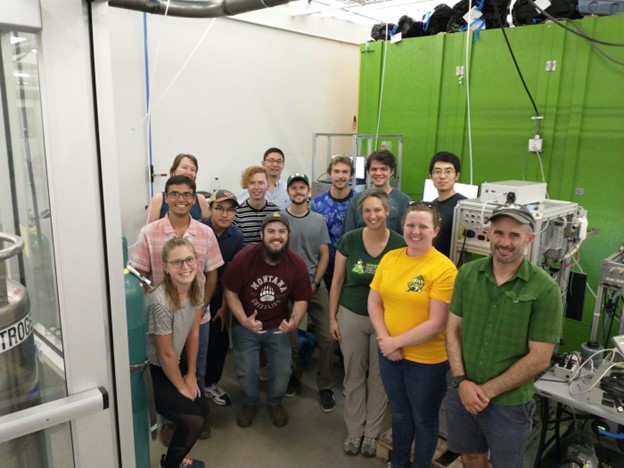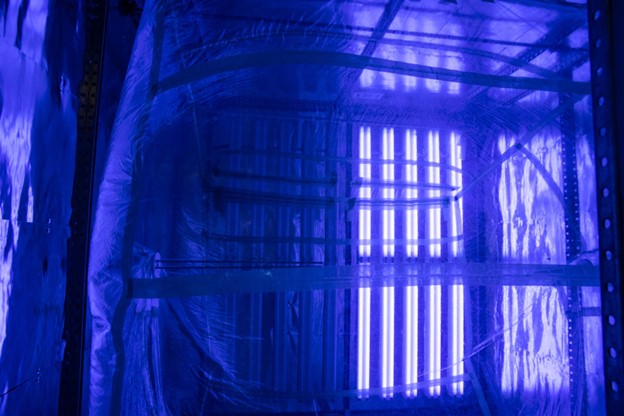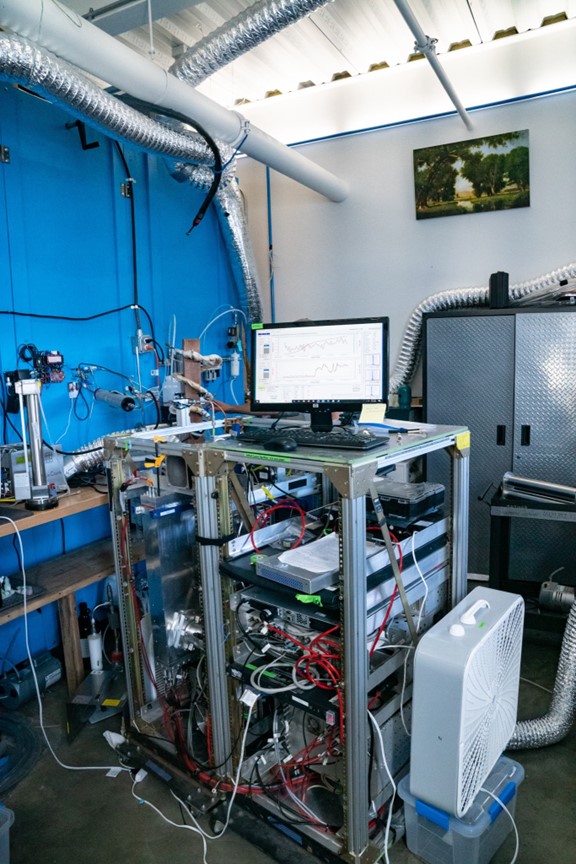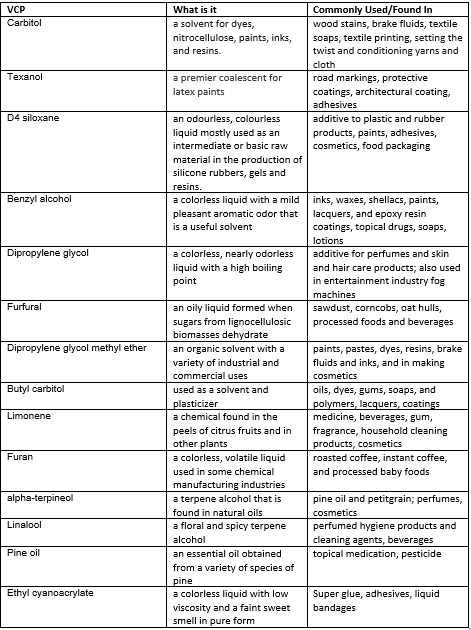Time to Decipher SCENTS
Time to Decipher SCENTS
By Austin Hannon | Events, PR, & Communications Coordinator at CSU Energy Institute

Common household items like hairspray and dish soap may come in small packages, but air pollution from these volatile chemical products may rival motor vehicle emissions when it comes to impacts on both the environment and human health.
Last year, Shantanu Jathar, Energy Institute researcher and associate professor in the department of mechanical engineering at Colorado State University, received grants totaling $1.48 million from the EPA, NSF and NOAA, paving the way for the creation of the Secondary organic aerosol Chamber Experiments on Non-Traditional Species (SCENTS) project.
Jathar, along with associate professor Delphine Farmer and assistant professor Megan Willis, both in the department of chemistry, co-led a team of graduate research assistants working on the SCENTS project. Other collaborators included faculty and researchers from the University of Montana, University of Colorado, UC Davis, and the National Oceanic and Atmospheric Administration (NOAA).
Throughout spring and summer, the SCENTS research team tested a range of organic molecules present in volatile chemical products, or VCPs, with a goal to identify harmful ingredients that could eventually be removed or replaced with an innocuous alternative. VCPs are found in everyday products like household cleaners, paint, personal care products, printing inks, pesticides, and adhesives used regularly by millions of people around the world.
Housed in the Laboratory for Aerosol Studies from Sources to Impacts (LASSI) at the CSU Powerhouse Energy Campus, the SCENTS research setup featured an intricate spaghetti junction of tubes, fans, monitors, and mass spectrometers surrounding a 3x3x3-meter wooden box. Inside, a ten-cubic-meter bag served as a controlled atmospheric environment for studying VCP gases. An array of ultraviolet lights also lined the interior of the box to mimic the sun’s effects.


The team conducted 34 experiments on 16 VCPs over two different time periods in spring and summer, finishing their final test on July 25. By the next day, the intricately designed box — once a magnet for attention from curious passersby — had been carefully disassembled and removed from the lab. Still, the project is only about a third of the way to completion, Jathar said.
“The next few years will be spent sifting through that data to narrate a story of what we observed in those experiments,” he said.
The students who supported the project played a leading role in creating a strong foundation for further work by the co-PIs and collaborators who will use those initial findings to draw conclusions on VCPs that could be replaced or eliminated altogether.
“The students are the engines and the center of all research that happens at the Powerhouse,” Jathar said. “They are the individuals that lead the project. As PIs, we are providing advice, support, and mentoring.”
Jathar added that many of the students will continue to work on SCENTS in various capacities as the project enters the next phase.
“We are meeting once a month as a team across all the institutions. Most of the students and some PIs will present their findings and data within our teams,” Jathar said. “There might be supporting evidence that some instruments gathered that can help others in their assessment. The first few months will be this exploratory data analysis.”
The Students Behind SCENTS
Meet the members of the student team involved in 34 experiments on 16 VCPs in the SCENTS’ two experimental windows of March 14 to April 29 and June 21 to July 25
Abe Dearden
(B.S. Atmospheric Oceanic Science at UCLA ’20; Pursuing a M.S. in Mechanical Engineering at CSU)
Dearden, a San Diego native, came to CSU after reaching out to Jathar because he was interested in air quality as a function of chemistry. He wanted to transition into engineering solutions rather than studying pure science.
Within SCENTS: Abe has been on the project since the start and essentially ran each experiment, ensuring a clean bag, the VCPs inserted, made sure the chamber was functioning as intended, and kept the lights on figuratively and literally.
What interests you most about SCENTS?: “The aspect that we are starting with is a clean baseline as opposed to out in the field where it is harder to see what you are viewing. There is so much going on in the field that it is hard to draw conclusions. However, with SCENTS, we put one thing in, and we observe it.”
Jamie Cast
(Pursuing a B.S. in Mechanical Engineering at CSU)
Cast, from eastern Washington, followed the footsteps of his older brother, who earned a PhD in Molecular Biology, to CSU. However, the younger Cast is interested in engineering and how things work.
Within SCENTS: Jamie joined at the start of this summer, which marked his first research job. His role entailed thoroughly cleaning instruments such as needles and beakers in a specific manner, because even a small amount of residue from a previous test can affect sample results.
What interests you most about SCENTS?: “The importance of the experiments makes me excited to be involved. Although that is not a specific part of the project, it really is just the philosophy of everything that occurs at the Powerhouse Energy Campus.”
Tucker Melles
(B.S. Astrobiology at Florida Tech ’18; Pursuing a Ph. D. in Chemistry at CSU)
Up until this summer when Melles, of Kansas City, started with SCENTS, his experience had mostly been in aqueous chemistry, so he welcomed the experience with gas chemistry.
Within SCENTS: Tucker runs the ammonium mass spectrometer, which is an instrument that detects oxidized compounds. Once the molecules in the chamber age and react, the mass spectrometer can document the formation process that leads to the aerosol phase.
What interests you most about SCENTS?: “The compounds we are investigating haven’t really been looked at as much as other things and they contribute a lot to aerosol formation. It is an emerging topic of interest as we cut back on fossil fuel combustion and transportation emissions.”
Damien Ketcherside
(B.S. Chemistry at Lewis Clark State College ’19; Pursuing a PhD in Analytical and Environmental Chemistry at University of Montana)
Working closely with Melles for the same amount of time but on a different spectrometer, Ketcherside made his way to Fort Collins with his knowledge of the proton transfer reaction — time of flight — mass spectrometer (PTR-TOF-MS). Prior to SCENTS, Ketcherside’s research has been around source attribution of gases.
Within SCENTS: The PTR-TOF-MS that Damien used specializes in smaller gases and the decay of the initial reactant. It measures the source and the changes of the gases overtime and the oxidation that is occurring. The findings help understand how these gases breakdown.
What interests you most about SCENTS?: “Up until SCENTS, most of my experience came from field work, which is complex to decipher considering the mixture of gases and trying to ascertain their origins. This project was very pristine and it was not hard to see something. It is irregular from the real world but its findings will be applied to the real world.”
Katelyn Rediger
(B.S. Chemistry at Eastern University ’19; Pursuing a M.S. Chemistry at CSU)
The Montross, Colo., native went east for undergrad, but returned closer to home to continue her education at Colorado State. Reidger does not want to get stuck in just molecules, but where it belongs in humanity and environmental justice thus believing that an emerging environmental chemistry is forthcoming as a branch of its own.
Within SCENTS: Katelyn helped monitor the third spectrometer in this project, a FIGAERO-CIMS, which acts as a hybrid between the other two spectrometers. The instrument measures compounds that are transitioning phases from gas to aerosol.
What interests you most about SCENTS?: “The collaboration. It takes so much to get these experiments running and we all have different things we are using the research for one way or another.”
Rediger is taking the same instrument to New York City next summer to test ambient air in a different study involving multiple universities. Participating in SCENTS has given her more time in characterizing the instrument and the organic compounds one at a time.
Amel Ksaibati
(Pursuing a B.S. Chemical Engineering at Wyoming)
Being born and raised in Cowboy country did not stop Ksaibati, of Laramie, Wyo., from wanting to be involved in Powerhouse. The Wyoming undergraduate is a part of a summer Research Experience for Undergraduates (REU) program for 10 weeks and living on campus in Fort Collins. Although she enjoys chemical engineering, she does have an interest in the environmental and energy side.
Within SCENTS: Amel got a head start on the group by looking into the data analysis of SCENTS 1. The long-term goal is to look at the secondary organic aerosol formations of the different VOCs. However, that takes a lot of analysis, so Amel mostly is looking at OH exposure and OH concentration on each experiment, which is an important input to further calculations.
What interests you most about SCENTS?: “I’ve been interested in working in air quality, so this was exactly the experience I wanted to enhance my skills and bridge knowledge from classwork. Specifically, I am using coding and practical knowledge from chemical engineering classes. It is cool to apply it to research.”
Ksaibati hopes this is not the last time researching in Fort Collins or Powerhouse as she aims to go to graduate school at CSU.
Cort Zang
(B.S. Chemistry at Salisbury University ’20; Pursuing a Ph. D. Chemistry at CSU)
The western Maryland product got involved in SCENTS by being familiar with the ammonium — chemical ionization mass (CIMS) spectrometer after a project he worked on last summer.
Within SCENTS: Cort is an instrument mentor of the ammonium chemical ionization mass spectrometer. While Tucker takes the lead on data analysis, Cort makes sure it is in a good spot for measurements, maintenance and calibrations.
What interests you most about SCENTS?: “Essentially, taking the data collected and making decisions on where to go from there is the fun part. The potential meaning behind the science is intriguing whether it is in further research or changes in the use of certain VCPs.”
After the conclusion of SCENTS, Zang will return to his previous project of method development and understanding the chemistry of ammonium as a reagent ion.
VCPs Tested

For More on the CSU Energy Institute follow: Twitter — CSUEnergy | Instagram — csuenergy | Facebook — energyinstitutecsu|TikTok — csuenergyinstitute
